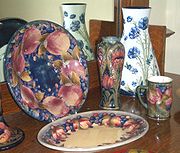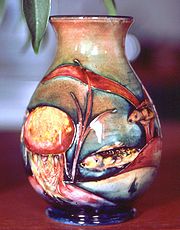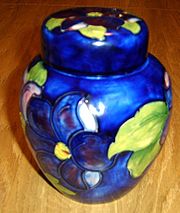
Moorcroft
Encyclopedia
Moorcroft is a British
pottery manufacturer based in Burslem
, Stoke-on-Trent
, Staffordshire
, which was founded by William Moorcroft
.
 In 1897 Staffordshire pottery manufacturers James Macintyre & Co. Ltd employed 24-year-old William Moorcroft as a designer, and within a year he was put in full charge of the company's art pottery studio
In 1897 Staffordshire pottery manufacturers James Macintyre & Co. Ltd employed 24-year-old William Moorcroft as a designer, and within a year he was put in full charge of the company's art pottery studio
. Moorcroft's first innovative range of pottery, called Florian Ware, was a great success and won him a gold medal at the St. Louis
International Exhibition in 1904. Unusually at that time, he adopted the practice of signing his name, or his initials, on nearly all the pottery he designed, the production of which he personally oversaw. In due course the extent to which his success had overshadowed Macintyre's other manufacturing activities resulted in resentment on the part of his employers, culminating in their decision in 1912 to close down his studio. He then set up his own company and the following year production of his pottery was transferred to a brand new factory nearby.
 The Moorcroft factory produced an extensive array of moderately-priced domestic tableware items in addition to its famous tubelined
The Moorcroft factory produced an extensive array of moderately-priced domestic tableware items in addition to its famous tubelined
, hand-painted art pottery. Moorcroft's reputation was enhanced when Queen Mary
, a keen collector of his works, granted him a royal warrant
in 1928. Shortly before the death of William in 1945, his elder son, Walter Moorcroft, took control of the business, which he continued to develop. The company's royal warrant was re-issued in his name in 1946.
Between its founding and its leadership under Walter Moorcroft, the company had been financed in collaboration with the famous London
store, Liberty
. The Liberty store's interest was bought out by Moorcroft in 1962.
Rising fuel and labour costs brought Moorcroft, with its highly labour-intensive techniques, into financial difficulties and in an attempt to mass produce
Moorcroft pottery, part of the company was sold to the Roper Brothers in 1984. This attempt was unsuccessful, and in 1986 Roper Brothers' share was resold to business partners Hugh Edwards and Richard Dennis. In 1992 Dennis and his pottery designer wife, Sally Tuffin, left the company, leaving the Edwards family as sole owners (remaining so in 2008).
Walter Moorcroft retired as the director of design in 1987, but continued to contribute until his last design, 'Rock of Ages', was launched in 1999. In 1993, 24-year-old Rachel Bishop joined the company as its senior designer. By claiming the original establishment of the Macintyre studio under William Moorcroft in 1897 as its own founding date, in 1997 Moorcroft celebrated its centenary. During 1998 it established a new Moorcroft Design Studio and employed several designers to extend the range of its products.
 Early in his employment at Macintyre's, William Moorcroft created designs for the company's Aurelian Ware range of high-Victorian pottery, which had transfer-printed and enamelled decoration in bold red, blue and gold colours. Introduced very soon afterwards, his art nouveau
Early in his employment at Macintyre's, William Moorcroft created designs for the company's Aurelian Ware range of high-Victorian pottery, which had transfer-printed and enamelled decoration in bold red, blue and gold colours. Introduced very soon afterwards, his art nouveau
-influenced Florian Ware was decorated entirely by hand, with the design outlined in trailed slip using a technique known as tubelining
. This technique has been used in almost all of Moorcroft's art pottery ever since, distinguishing it from mass-produced pottery. Both father and son also experimented with high-temperature flambé techniques, producing high glaze with vibrant colour.
 Later Walter Moorcroft designs reflect the simpler appearance preferred during his era. Moorcroft Design Studio patterns show strong influences from the founding days of William Moorcroft coupled with the advances in colouring techniques of more recent years. Aimed at the luxury end of the collector and gift markets, they are generally in the form of such products as display plates, vases, pin dishes, lamp-bases and jars of varying shape and size.
Later Walter Moorcroft designs reflect the simpler appearance preferred during his era. Moorcroft Design Studio patterns show strong influences from the founding days of William Moorcroft coupled with the advances in colouring techniques of more recent years. Aimed at the luxury end of the collector and gift markets, they are generally in the form of such products as display plates, vases, pin dishes, lamp-bases and jars of varying shape and size.
United Kingdom
The United Kingdom of Great Britain and Northern IrelandIn the United Kingdom and Dependencies, other languages have been officially recognised as legitimate autochthonous languages under the European Charter for Regional or Minority Languages...
pottery manufacturer based in Burslem
Burslem
The town of Burslem, known as the Mother Town, is one of the six towns that amalgamated to form the current city of Stoke-on-Trent, in the ceremonial county of Staffordshire, in the Midlands of England.-Topography:...
, Stoke-on-Trent
Stoke-on-Trent
Stoke-on-Trent , also called The Potteries is a city in Staffordshire, England, which forms a linear conurbation almost 12 miles long, with an area of . Together with the Borough of Newcastle-under-Lyme Stoke forms The Potteries Urban Area...
, Staffordshire
Staffordshire
Staffordshire is a landlocked county in the West Midlands region of England. For Eurostat purposes, the county is a NUTS 3 region and is one of four counties or unitary districts that comprise the "Shropshire and Staffordshire" NUTS 2 region. Part of the National Forest lies within its borders...
, which was founded by William Moorcroft
William Moorcroft (potter)
William Moorcroft was an English potter who founded the Moorcroft pottery business.He was born in Burslem, Staffordshire. He studied art at Burslem then in London and Paris. He experimented with his own pottery designs around 1896 while working for James Macintyre & Co Ltd. and produced Aurelian...
.
History

Studio
A studio is an artist's or worker's workroom, or the catchall term for an artist and his or her employees who work within that studio. This can be for the purpose of architecture, painting, pottery , sculpture, scrapbooking, photography, graphic design, filmmaking, animation, radio or television...
. Moorcroft's first innovative range of pottery, called Florian Ware, was a great success and won him a gold medal at the St. Louis
St. Louis, Missouri
St. Louis is an independent city on the eastern border of Missouri, United States. With a population of 319,294, it was the 58th-largest U.S. city at the 2010 U.S. Census. The Greater St...
International Exhibition in 1904. Unusually at that time, he adopted the practice of signing his name, or his initials, on nearly all the pottery he designed, the production of which he personally oversaw. In due course the extent to which his success had overshadowed Macintyre's other manufacturing activities resulted in resentment on the part of his employers, culminating in their decision in 1912 to close down his studio. He then set up his own company and the following year production of his pottery was transferred to a brand new factory nearby.

Tubelining
Tubelining is a technique of ceramic decoration. It involves squeezing a thin line of clay body through a nozzle onto the ware being decorated. An alternative term is "slip trailing"....
, hand-painted art pottery. Moorcroft's reputation was enhanced when Queen Mary
Mary of Teck
Mary of Teck was the queen consort of the United Kingdom and the British Dominions, and Empress of India, as the wife of King-Emperor George V....
, a keen collector of his works, granted him a royal warrant
Royal Warrant
Royal warrants of appointment have been issued for centuries to those who supply goods or services to a royal court or certain royal personages. The warrant enables the supplier to advertise the fact that they supply to the royal family, so lending prestige to the supplier...
in 1928. Shortly before the death of William in 1945, his elder son, Walter Moorcroft, took control of the business, which he continued to develop. The company's royal warrant was re-issued in his name in 1946.
Between its founding and its leadership under Walter Moorcroft, the company had been financed in collaboration with the famous London
London
London is the capital city of :England and the :United Kingdom, the largest metropolitan area in the United Kingdom, and the largest urban zone in the European Union by most measures. Located on the River Thames, London has been a major settlement for two millennia, its history going back to its...
store, Liberty
Liberty (department store)
Liberty is a long-established department store in Regent Street in Central London, England, in the West End shopping district.-Early years:...
. The Liberty store's interest was bought out by Moorcroft in 1962.
Rising fuel and labour costs brought Moorcroft, with its highly labour-intensive techniques, into financial difficulties and in an attempt to mass produce
Mass production
Mass production is the production of large amounts of standardized products, including and especially on assembly lines...
Moorcroft pottery, part of the company was sold to the Roper Brothers in 1984. This attempt was unsuccessful, and in 1986 Roper Brothers' share was resold to business partners Hugh Edwards and Richard Dennis. In 1992 Dennis and his pottery designer wife, Sally Tuffin, left the company, leaving the Edwards family as sole owners (remaining so in 2008).
Walter Moorcroft retired as the director of design in 1987, but continued to contribute until his last design, 'Rock of Ages', was launched in 1999. In 1993, 24-year-old Rachel Bishop joined the company as its senior designer. By claiming the original establishment of the Macintyre studio under William Moorcroft in 1897 as its own founding date, in 1997 Moorcroft celebrated its centenary. During 1998 it established a new Moorcroft Design Studio and employed several designers to extend the range of its products.
Moorcroft Pottery

Art Nouveau
Art Nouveau is an international philosophy and style of art, architecture and applied art—especially the decorative arts—that were most popular during 1890–1910. The name "Art Nouveau" is French for "new art"...
-influenced Florian Ware was decorated entirely by hand, with the design outlined in trailed slip using a technique known as tubelining
Tubelining
Tubelining is a technique of ceramic decoration. It involves squeezing a thin line of clay body through a nozzle onto the ware being decorated. An alternative term is "slip trailing"....
. This technique has been used in almost all of Moorcroft's art pottery ever since, distinguishing it from mass-produced pottery. Both father and son also experimented with high-temperature flambé techniques, producing high glaze with vibrant colour.


